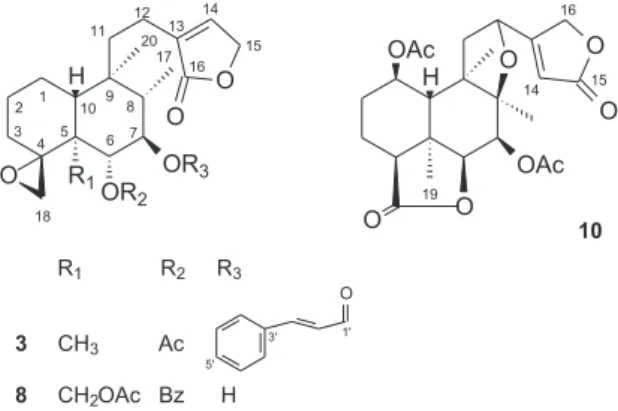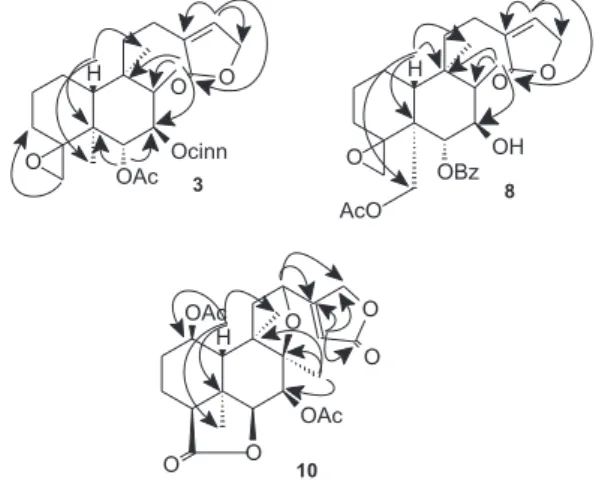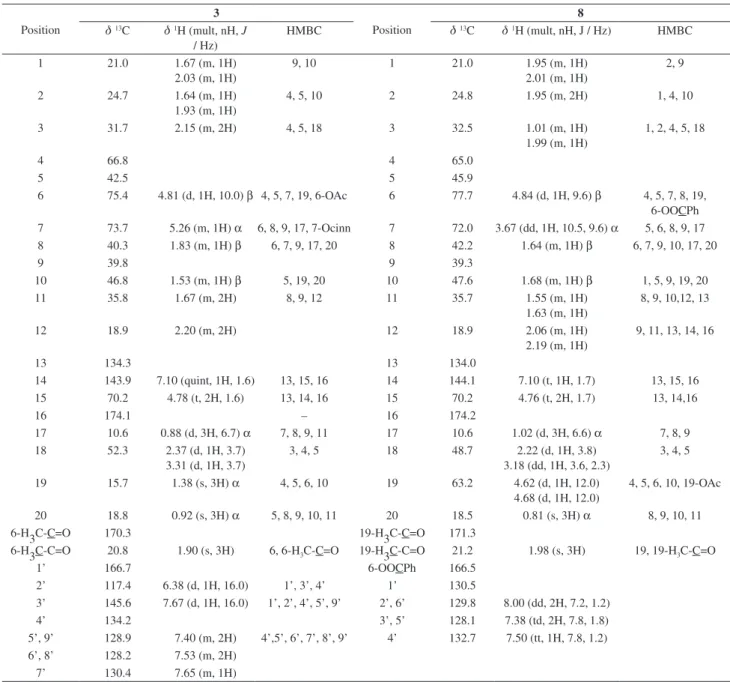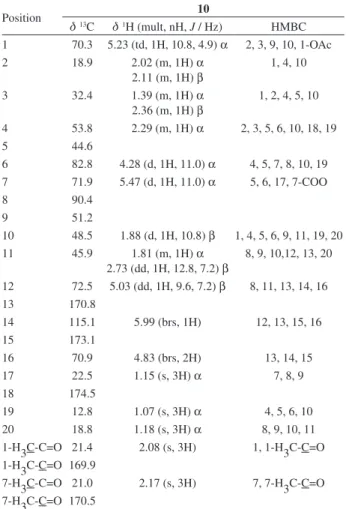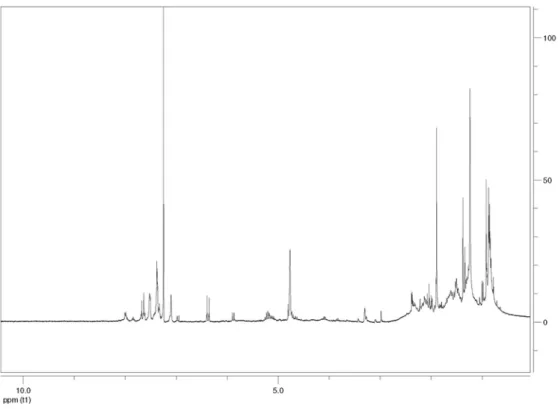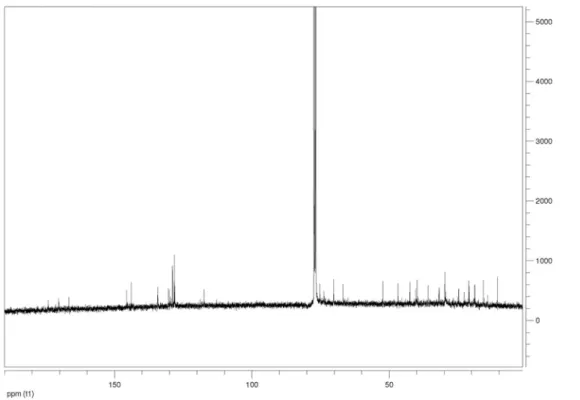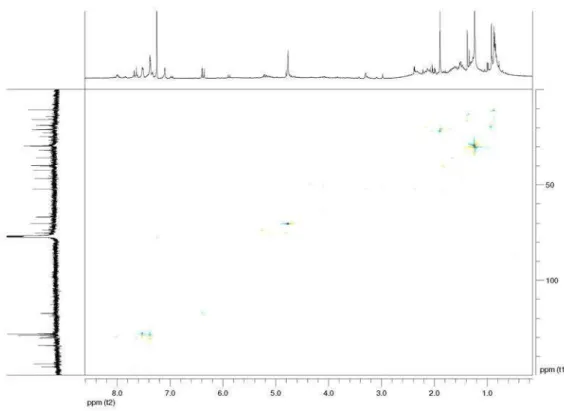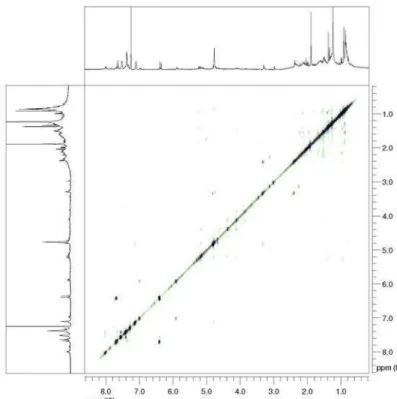Article
J. Braz. Chem. Soc., Vol. 24, No. 12, 1950-1956, 2013. Printed in Brazil - ©2013 Sociedade Brasileira de Química 0103 - 5053 $6.00+0.00
A
http://dx.doi.org/10.5935/0103-5053.20130244*e-mail: disabel@ubi.pt
New neo-Clerodanes from Tinnea antiscorbutica Welv.
Cristina M. P. Borges,a Dina I. M. D. de Mendonça,*,b Sandra C. S. Pinheiro,b
Liliana Vieira,b António J. G. Mendonça,c Jorge F. Gaspar,d Célia Martins,d
Carlos Diakanawmae and José Rueffd
aChemistry Department, Agostinho Neto University, Av. 4 de Fevereiro, No. 7, Luanda, Angola
bTextile and Paper Materials Center and Chemistry Department, University of Beira Interior,
Rua Marquês d’Ávila e Bolama, 6200-001 Covilhã, Portugal
cCICS-UBI – Health Sciences Research Centre, University of Beira Interior,
Av. Infante D. Henrique, 6201-506 Covilhã, Portugal
dDepartmentof Genetics, Faculty of Medical Sciences, New University of Lisbon,
1349-008 Lisboa, Portugal
eBiology Department, Agostinho Neto University, Av. 4 de Fevereiro, No. 7, Luanda, Angola
Três novos neo-clerodanos, antiscorbuticano A, antiscorbuticano B, e antiscorbuticano C e os compostos conhecidos glutinol, friedelina, 5,7-di-hidroxiflavanona (pinocembrina), 5-hidroxi-3,6,7,4’-tetrametoxiflavona, 5-hidroxi-3,6,7,3’,4’-pentametoxiflavona (artemetina), 5,4’-di-hidroxi-3,6,7,3’-tetrametoxiflavona (penduletina) e 5,3’,4’-tri-hidroxi-3,6,7-trimetoxiflavona (crisosplenol D) foram isolados do extrato de metanol de Tinnea antiscorbutica. O composto antiscorbuticano B não apresentou atividade mutagênica para doses até 250 µg por caixa (teste de Ames) e não induziu micronúcleos na linha celular V79 em doses até 100 µg mL-1.
Three new neo-clerodanes, antiscorbuticane A, antiscorbuticane B and antiscorbuticane C, and known compounds glutinol, friedelin, 5,7-dihydroxyflavanone (pinocembrin), 5-hydroxy-3,6,7,4’-tetramethoxyflavone, 5-hydroxy-3,6,7,3’,4’-pentamethoxyflavone (artemetin), 5,4’-dihydroxy-3,6,7,3’-tetramethoxyflavone (penduletin) and 5,3’,4’-trihydroxy-3,6,7-trimethoxyflavone (chrysosplenol D), were isolated from the methanol extract of Tinnea antiscorbutica. Antiscorbuticane B exhibited no mutagenic activity at doses of up to 250 µg per plate (Ames test) and did not induce micronucleus formation in the V79 cell line at doses of up to 100 µg mL-1.
Keywords: Tinnea antiscorbutica, neo-clerodanes, mutagenic activity, cytotoxic activity, genotoxicity
Introduction
The Tinnea genera belong to the Labiatea Juss. family1
and comprise 19 species restricted to Africa. Originally from the north of Angola, in the province of Kuanza Norte (Dembos region), T. antiscorbutica Welv., which is traditionally named “Tete-Mbula”, is a small shrub that can be collected in several regions of Angola and is used in folk medicine to treat scurvy.1 Despite the use of T. barbata as
a flowering shrub,2 to the best of our knowledge there have
been no chemical studies of the Tinnea genera.
Following our research on Angolan plants,3-6 we report
the isolation of the new neo-clerodanes antiscorbuticane A (3), antiscorbuticane B (8) and antiscorbuticane C (10) and the known compounds glutinol (1),7,8
friedelin (2),9 5,7-dihydroxyflavanone (pinocembrin) (4),10
5-hydroxy-3,6,7,4’-tetramethoxyflavone (5),11,12
5-hydroxy-3,6,7,3’,4’-pentamethoxyflavone (artemetin) (6),13
5,4’-dihydroxy-3,6,7,3’-tetramethoxyflavone (7),14
5,3’,4’-trihydroxy-3,6,7-trimethoxyflavone (9)
(chrysosplenol D)15 from the methanol extract of the aerial
Borges et al. 1951 Vol. 24, No. 12, 2013
Experimental
General experimental procedures
The optical rotations were obtained with a Bellingham+Stanley Ltd. ADP 220 polarimeter. The high resolution electron ionization mass spectrometry (HREIMS) measurements were performed on a VG Autospec M and were recorded at 70 eV. The infrared (IR) spectra were measured with a Unicam Mattson 5000 FTIR. The nuclear magnetic resonance (NMR) spectra were recorded with a Bruker Avance II at 600 MHz (1H NMR) and 150.9 MHz
(13C NMR) in CDCl
3. The chemical shifts are given in
d ppm and are referenced to the residual CHCl3 at 7.26 ppm
for the 1H spectrum and 77.0 ppm for the 13C spectrum.
Two-dimensional experiments were performed with standard Bruker software. Column chromatography was performed on silica gel 60 (70-230 mesh, Merck, Darmstadt, Germany).
Plant material
The aerial parts of Tinnea antiscorbutica were collected in the Chibia road at the Comuna da Huíla, Huíla province (Angola), in July 2001 and were identified by Professor Esperança da Costa, Agostinho Neto University. A voucher specimen (No. 3742) has been deposit at the Lubango Herbarium, Angola.
Extraction and isolation
The dried aerial parts (1.5 kg) were macerated in methanol for a week at room temperature; the procedure was performed three times. After being concentrated, the methanol extract (42.7 g) was partitioned between MeOH-H2O (5:1) and
hexane to yield 19.0 g of the hexane fraction. The aqueous methanolic fraction was concentrated under vacuum, H2O
was added, and the fraction was extracted with chloroform
to give the chloroform fraction (2.8 g). Finally, the aqueous fraction was extracted with EtOAc to yield 9.3 g of the EtOAc fraction, and the remaining material was considered to be the aqueous fraction (10.4 g).
A sample of the hexane fraction (2 g) was fractionated on a silica gel column with a hexane/EtOAc, EtOAc and EtOAc/MeOH gradient. The fraction eluted with hexane/ EtOAc (9:1) was separated on a silica gel column with a hexane/EtOAc gradient (99:1; 49:1; 9:1; 4:1; 7:3; 1:1) to yield glutinol (1) (7.9 mg) and friedelin (2) (5.4 mg). The fraction eluted with hexane/EtOAc 3:2 was separated on a silica gel column with a hexane/EtOAc gradient (4:1; 7:3; 3:2; 1:1) and EtOAc to yield antiscorbuticane A (3) (5.5 mg).
The chloroform fraction (2.8 g) was fractionated on a silica gel column with a hexane/EtOAc, EtOAc/CHCl3
and EtOAc/CH3OH gradient. The fraction eluted with
hexane/EtOAc 9:1 was separated on a silica gel column with a hexane/EtOAc gradient (9:1; 4:1; 7:3; 1:1) to yield 5,7-dihydroxyflavanone (4) (2.5 mg) and 5-hydroxy-3,6,7,4’-tetramethoxyflavone (5) (3.5 mg). The fractions eluted with the EtOAc/CH3OH gradient were combined and
subjected to successive purification on a silica gel column to yield 5-hydroxy-3,6,7,3’,4’-pentamethoxyflavone (6) (5.2 mg), 5,4’-dihydroxy-3,6,7,3’-tetramethoxyflavone (7)
(3.5 mg), antiscorbuticane B 8 (25.1 mg) and
5,3’,4’-trihydroxy-3,6,7-trimethoxyflavone (9) (11.6 mg). The ethyl acetate fraction (9.3 g) was fractionated on a silica gel column with a hexane/EtOAc, EtOAc and EtOAc/ MeOH gradient. The fraction eluted with hexane/EtOAc (3:2) was separated on a silica gel column with a hexane/ CHCl3 gradient to yield antiscorbuticane C (10) (9.3 mg).
Antiscorbuticane A (3)
Colorless oil; [α]D21 = + 22.2 (c 0.045, CHCl3); IR υmax/cm
-1 2929, 1750-1715, 1636, 1451, 1251, 1203, 1168,
754; 1H NMR (CDCl
3, 600 MHz) and 13C NMR (CDCl3,
150.9 MHz): see Table 1; HR-FAB-MS (pos.) m/z 523.2686 [M+H]+ (calcd. for C
31H39O7, 523.2696).
Antiscorbuticane B (8)
White amorphous solid; [α]D
18 = + 19.2 (c 0.26,
CHCl3); IR υmax/cm-1 2982, 1762-1717, 1638, 1240, 1165,
750; 1H NMR (CDCl
3, 600 MHz) and
13C NMR (CDCl
3,
150.9 MHz): see Table 1; HR-FAB-MS (pos.) m/z 535.2296 [M+Na]+ (calcd. for C
29H36O8Na, 535.2308).
Antiscorbuticane C (10)
Colorless oil; [α]D16 = + 57.1 (c 0.07, CHCl3); IR υmax/cm
-1 2986, 1778, 1747, 1639, 1619, 1444, 1372, 1228,
1170, 1032, 756. 1H NMR (CDCl
3, 600 MHz) and 13C NMR
New neo-Clerodanes from Tinnea antiscorbutica Welv. J. Braz. Chem. Soc. 1952
(CDCl3, 150.9 MHz): see Table 2; HR-TOF-MS-EI (pos.)
m/z 462.1885 [M]+ (calcd. C
24H30O9, 462.1890).
MTT cytotoxicity assay
The MTT assay was conducted in V79 Chinese hamster cells as described elsewhere.6 Three independent
experiments were performed.
Ames assay
Mutagenicity testing was conducted through the plate incorporation assay described by Maron and Ames16 with
the Salmonella typhimurium strains TA 98, TA 100 and TA 102 in the presence or absence of S9 mix.16 At least two
independent experiments were performed for each assay.
Cytokinesis-block micronucleus assay (CBMN)
Cytokinesis-block micronucleus assay was conducted
as described elsewhere.6 At least two independent
experiments were performed for each assay.
Results and Discussion
Previous phytochemical studies demonstrated that certain of the known compounds isolated from Tinnea antiscorbutica present different biological activities. Glutinol presents analgesic and anti-inflammatory properties;17-19
5,7-dihydroxyflavanone (pinocembrin) is well known for its vasorelaxing effects,20,21 antimutagenic activity,22
induction of apoptosis,23 bacteriostactic activity24 and
fasciolicide, ovicide and larvicide activities.15
5-Hydroxy-3,6,7,4’-tetramethoxyflavone presents antifungal activity11
and inhibitory activity against prolylendopeptidase and thrombin.25 5-Hydroxy-3,6,7,3’,4’-pentamethoxyflavone
(artemetin) induces apoptosis in different target cells26,27 and
has cytotoxic and antioxidant activity.28,29
5,4’-Dihydroxy-3,6,7,3’-tetramethoxyflavone presents cytotoxic activity.30 5,3’,4’-Trihydroxy-3,6,7-trimethoxyflavone
(chrysosplenol D) induces apoptosis in mammalian cancer cells.26
Compound 3 was obtained as a colorless oil with an [α]D
21 value of + 22.2° (c 0.045, CHCl
3). The molecular
formula C31H38O7 was established by HR-FAB-MS, which
showed a quasi-molecular ion peak at m/z 523.2686
[M+H]+ (calculated at 523.2696) and implied 13 degrees
of unsaturation.
The 1H-NMR spectrum of compound 3 (Table 1)
displayed signals for four methyl groups: one acetate at dH
1.90, two Me singlets at dH 1.38 and 0.92, and a secondary
Me at dH 0.88 (d, 3H, J 6.7 Hz); one diastereotopic
oxymethylene, which presented HMBC correlations with C-3, C-4 (Figure 2), at dH 3.31 (d, 1H, J 3.7 Hz) and 2.37
(d, 1H, J 3.7 Hz); an E-cinnamoyloxy moiety (dH 6.38, d,
1H, J 16.0 Hz, H-2’; 7.67, d, 1H, J 16.0 Hz, H-3’; 7.40, 7.53, 7.65, m, 5H, H-5’, 6’, 7’, 8’, 9’); an α-substituted butenolide ring31 with H-14 at d
H 7.10 (quint, 1H, J 1.6 Hz)
that presented a vicinal coupling to H-15 at dH 4.78 (t, 2H,
J 1.6 Hz); and an allylic coupling to H-12 characteristic of some neo-clerodane diterpenoides.31,32 The 13C NMR
spectrum (Table 1) showed 29 signals corresponding to 31 carbons, which were determined to be four methyls, seven methylenes, twelve methines and eight quaternary carbons from the DEPT spectrum of 3. The 13C-NMR chemical
shifts of the three methyls (dC 18.8, 15.7, and 10.6), the
oxymethylene (dC 52.3), the four methines (dC 75.4,
73.7, 46.8, and 40.3) and the three quaternary carbons (dC 66.8, 42.5, and 39.8) were found to be consistent
with a trans-fused A/B ring clerodane structure31,33 in
which Me-18 was transformed into a 4,18-epoxy ring and ring B contained an acetate and an E-cinnamate group. The α-substituted butenolide ring (dC 134.3, 143.9, and
70.2 as C-13, C-14, and C-15 and 174.1 as C-16) can unambiguously be assigned to the H-14 and CH2-15 groups
with the aid of the 1H–1H COSY, HSQC and HMBC data
(Table 1, Figure 2). The NOESY correlations (Figure 3) between Me-17/Me-19, Hα-7, and Me-19/Me-20 indicated that H-7, Me-17, Me-19, and Me-20 were on the α-face of the molecule. Additionally, the NOESY correlation between Hβ-10/Hβ-6 suggested that these hydrogens were on the β-face of the molecule. Thus, the structure of compound 3 was established as 6α-acetoxy-(E),7β -cinnamoyloxy-4α,18-epoxy-neo-clerodan-15,16-olide and was called antiscorbuticane A (Figure 1).
Compound 8 was obtained as a colorless oil with an [α]D
18 value of + 19.2° (c 0.26, CHCl
3). The molecular
Borges et al. 1953 Vol. 24, No. 12, 2013
formula C29H36O8 was established by HR-FAB-MS by
observing the ion of the Na+-adduct at m/z 535.2296
(calculated for 535.2308), which implied 11 degrees of unsaturation.
Compound 8 had a 1H-NMR profile similar to that of 3
except for the moieties at C-6 and C-7 and the absence of Me-19. The 1H and 13C-NMR spectra (Table 1) indicated
the presence of two methyls (dH 1.02, d, 3H, J 6.6 Hz; and
0.81, s, 3H; dC 10.6, 18.5), an acetate group (dH 1.98, s,
3H; dC 171.3, 21.2) attached to C-19, a benzoyloxy moiety
(dH 8.00, dd, 2H J 7.2 Hz, 1.2 Hz, H-2’ and H-6’; 7.50,
tt, 1H, J 7.8 Hz, 1.2 Hz, H-4’; and 7.38, td, 2H, J 7.8 Hz, 1.8 Hz, H-3’ and H-5’; dC 166.5, 6-OOCPh; 130.5 C-1’;
Figure 3. NOESY correlations of 3, 8 and 10.
Table 1. 1H NMR and 13C NMR data and HMBC correlations of compounds 3 and 8a
Position
3
Position
8
d13C d1H (mult, nH, J
/ Hz)
HMBC d13C d1H (mult, nH, J / Hz) HMBC
1 21.0 1.67 (m, 1H)
2.03 (m, 1H)
9, 10 1 21.0 1.95 (m, 1H)
2.01 (m, 1H)
2, 9
2 24.7 1.64 (m, 1H)
1.93 (m, 1H)
4, 5, 10 2 24.8 1.95 (m, 2H) 1, 4, 10
3 31.7 2.15 (m, 2H) 4, 5, 18 3 32.5 1.01 (m, 1H)
1.99 (m, 1H)
1, 2, 4, 5, 18
4 66.8 4 65.0
5 42.5 5 45.9
6 75.4 4.81 (d, 1H, 10.0) β 4, 5, 7, 19, 6-OAc 6 77.7 4.84 (d, 1H, 9.6) β 4, 5, 7, 8, 19, 6-OOCPh 7 73.7 5.26 (m, 1H) α 6, 8, 9, 17, 7-Ocinn 7 72.0 3.67 (dd, 1H, 10.5, 9.6) α 5, 6, 8, 9, 17 8 40.3 1.83 (m, 1H) β 6, 7, 9, 17, 20 8 42.2 1.64 (m, 1H) β 6, 7, 9, 10, 17, 20
9 39.8 9 39.3
10 46.8 1.53 (m, 1H) β 5, 19, 20 10 47.6 1.68 (m, 1H) β 1, 5, 9, 19, 20
11 35.8 1.67 (m, 2H) 8, 9, 12 11 35.7 1.55 (m, 1H)
1.63 (m, 1H)
8, 9, 10,12, 13
12 18.9 2.20 (m, 2H) 12 18.9 2.06 (m, 1H)
2.19 (m, 1H)
9, 11, 13, 14, 16
13 134.3 13 134.0
14 143.9 7.10 (quint, 1H, 1.6) 13, 15, 16 14 144.1 7.10 (t, 1H, 1.7) 13, 15, 16
15 70.2 4.78 (t, 2H, 1.6) 13, 14, 16 15 70.2 4.76 (t, 2H, 1.7) 13, 14,16
16 174.1 – 16 174.2
17 10.6 0.88 (d, 3H, 6.7) α 7, 8, 9, 11 17 10.6 1.02 (d, 3H, 6.6) α 7, 8, 9
18 52.3 2.37 (d, 1H, 3.7) 3.31 (d, 1H, 3.7)
3, 4, 5 18 48.7 2.22 (d, 1H, 3.8)
3.18 (dd, 1H, 3.6, 2.3)
3, 4, 5
19 15.7 1.38 (s, 3H) α 4, 5, 6, 10 19 63.2 4.62 (d, 1H, 12.0)
4.68 (d, 1H, 12.0)
4, 5, 6, 10, 19-OAc
20 18.8 0.92 (s, 3H) α 5, 8, 9, 10, 11 20 18.5 0.81 (s, 3H) α 8, 9, 10, 11
6-H3C-C=O 170.3 19-H3C-C=O 171.3
6-H3C-C=O 20.8 1.90 (s, 3H) 6, 6-H3C-C=O 19-H3C-C=O 21.2 1.98 (s, 3H) 19, 19-H3C-C=O
1’ 166.7 6-OOCPh 166.5
2’ 117.4 6.38 (d, 1H, 16.0) 1’, 3’, 4’ 1’ 130.5
3’ 145.6 7.67 (d, 1H, 16.0) 1’, 2’, 4’, 5’, 9’ 2’, 6’ 129.8 8.00 (dd, 2H, 7.2, 1.2)
4’ 134.2 3’, 5’ 128.1 7.38 (td, 2H, 7.8, 1.8)
5’, 9’ 128.9 7.40 (m, 2H) 4’,5’, 6’, 7’, 8’, 9’ 4’ 132.7 7.50 (tt, 1H, 7.8, 1.2) 6’, 8’ 128.2 7.53 (m, 2H)
7’ 130.4 7.65 (m, 1H)
New neo-Clerodanes from Tinnea antiscorbutica Welv. J. Braz. Chem. Soc. 1954
129.8, C-2’ and C-6’; 128.1 C-3’ and C-5’, and 132.7, C-4’) attached to C-6; an α-substituted butenolide ring (dH 7.10,
1H, t, J 1.7 Hz, H-14; and 4.76, 2H, q, J 1.7 Hz, H-15; dC
134.0, 144.1, and 70.2, C-13, C-14, and C-15, respectively; and 174.2, C-16),31 and two diastereotopic oxymethylenes
(dH 3.18, dd, 1H, J 3.8 Hz, 2.3 Hz and 2.37, d, 1H, J 3.6
Hz, H-18; and 4.68, 4.62, 1H, d, J = 12.0 Hz each, H-19; dC 48.7, C-18; 63.2, C-19). The
1H and 13C-NMR data were
found to be consistent with a trans-fused A/B ring clerodane structure31,33 in which Me-18 was transformed into a
4,18-epoxy ring, Me-19 transformed into an oxymethylene bearing an acetate moiety, and ring B bears an hydroxyl and a benzoyl group (Figure 1).
The NOESY correlations (Figure 3) between Hα-7/Me-17, Me-20, and CH2-19 indicated that H-7, Me-17, CH2-19 and
Me-20 were on the α-face of the molecule. Additionally, the NOESY correlation between Hβ-10 and Hβ-6 suggested that these hydrogens were on the β-face of the molecule. Thus, the structure of compound 8 was established as 19-acetoxy-6α-benzoyloxy-4α,18-epoxy-7β-hydroxy-neo -clerodan-15,16-olide and was named antiscorbuticane B (Figure 1).
Compound 10 was obtained as a colorless oil with an [α]D
16 value of + 57.1° (c 0.07, CHCl
3). The molecular
formula C24H30O9 was established by HR-TOF-MS-EI,
which showed a molecular ion peak at m/z 462.1885
(calculated for 462.1890) and implied 10 degrees of unsaturation.
The 1H and 13C-NMR spectra of 10 (Table 2) showed
signals for two acetate groups (dH 2.08, s 3H, and 2.17,
s, 3H, ; dC 21.4, 169.9 and 21.0, 170.5), three methyl
groups (dH 1.18, s, 3H, Me-20; 1.15, s, 3H, Me-17 and
1.07, s, 3H, Me-19), a β-substituted butenolide ring (dH 5.99, br s, 1H and 4.83, br s, 2H; dC 115.1 and 70.9),
34
which can be assigned to the H-14 vinylic proton and to the C-16 methylene, respectively, with the aid of 1H–1H
COSY, HSQC and HMBC data (Table 2, Figure 2); and four oxymethines (dH 5.47, d, 1H, J 11.0 Hz, H-7; 5.23,
td, 1H, J 10.8, 4.9 Hz, H-1; 5.03, dd, 1H, J 9.9 Hz, 7.2 Hz, H-12 and 4.28, d, 1H, J 11.0 Hz, H-6; dC 71.9, 70.3,
72.5 and 82.8). The dH 5.23 and 5.47 methines showed
HMBC correlations with the dC 169.9 and 170.5 carbonyl
acetates, respectively, and were located on C-1 and C-7. The 1H–1H COSY correlations showed the connectivity
between the protons at dH 4.28 and H-7 and suggested the
placement of this methine at C-6. The 1H and 13C NMR
data were found to be consistent with a trans-fused A/B ring clerodane structure,31,33 in which Me-18 was
transformed into a lactone carbonyl (dC 174.50). The
low field shifts of Me-17 and Me-20 and the H-12/C-8 HMBC correlation clearly indicated the presence of an
8β,12 cyclic ether.35 Because the αposition of Me-19 was
already established (trans-fused A/B ring), the NOESY correlations (Figure 3) between Me-19/Hα-1, Hα-4, Hα-7 and Hα-7/Hα-4, Hα-6, Me-17 indicated that H-1, H-4, H-6, H-7, Me-17 and Me-19 were on the α-face of the molecule. Additionally, the NOESY correlation between Hβ-10 and Hβ-12 suggested that these hydrogens were on the β-face of the molecule. Thus, the structure of compound 10 was established as 1β,7β -diacetoxy-8β,12-epoxy-neo-clerodan-16,15:18β,6β-diolide and was named antiscorbuticane C (Figure 1).
Regarding the potential genetic damage induced by compound 8, there is no evidence of mutagenic activity at doses of up to 250 µg per plate (Ames test, Table 3), and compound 8 does not induce micronuclei in the V79 cell line at doses of up to 100 µg mL-1 (Table 4). Furthermore
compound 8 don’t present cytotoxic activity (Table 5). Compounds 3 and 10 were not tested due the lack of available sample amount.
Table 2. 1H NMR and 13C NMR data and HMBC correlations of
compound 10a
Position 10
d13C d1H (mult, nH, J / Hz) HMBC
1 70.3 5.23 (td, 1H, 10.8, 4.9) α 2, 3, 9, 10, 1-OAc
2 18.9 2.02 (m, 1H) α
2.11 (m, 1H) β
1, 4, 10
3 32.4 1.39 (m, 1H) α
2.36 (m, 1H) β
1, 2, 4, 5, 10
4 53.8 2.29 (m, 1H) α 2, 3, 5, 6, 10, 18, 19
5 44.6
6 82.8 4.28 (d, 1H, 11.0) α 4, 5, 7, 8, 10, 19 7 71.9 5.47 (d, 1H, 11.0) α 5, 6, 17, 7-COO
8 90.4
9 51.2
10 48.5 1.88 (d, 1H, 10.8) β 1, 4, 5, 6, 9, 11, 19, 20
11 45.9 1.81 (m, 1H) α
2.73 (dd, 1H, 12.8, 7.2) β
8, 9, 10,12, 13, 20
12 72.5 5.03 (dd, 1H, 9.6, 7.2) β 8, 11, 13, 14, 16
13 170.8
14 115.1 5.99 (brs, 1H) 12, 13, 15, 16
15 173.1
16 70.9 4.83 (brs, 2H) 13, 14, 15
17 22.5 1.15 (s, 3H) α 7, 8, 9
18 174.5
19 12.8 1.07 (s, 3H) α 4, 5, 6, 10
20 18.8 1.18 (s, 3H) α 8, 9, 10, 11
1-H3C-C=O 21.4 2.08 (s, 3H) 1, 1-H3C-C=O 1-H3C-C=O 169.9
7-H3C-C=O 21.0 2.17 (s, 3H) 7, 7-H3C-C=O 7-H3C-C=O 170.5
aSpectra were recorded at 600 MHz for 1H NMR and 150.9 MHz for 13C
Borges et al. 1955 Vol. 24, No. 12, 2013
Conclusions
The present phytochemical investigation of aerial parts of
T. antiscorbutica Welv., afforded three new neo-clerodanes named as antiscorbuticane A, antiscorbuticane B and
antiscorbuticane C, and seven known compounds, glutinol, friedelin, 5,7-dihydroxyflavanone (pinocembrin), 5-hydroxy-3,6,7,4’-tetramethoxyflavone, 5-hydroxy-3,6,7,3’,4’-pentamethoxyflavone (artemetin), 5,4’-dihydroxy-3,6,7,3’-tetramethoxyflavone (penduletin) and 5,3’,4’-trihydroxy-3,6,7-trimethoxyflavone (chrysosplenol D).
Genotoxicity, mutagenicity and cytotoxicity were tested for antiscorbuticane B but all assays were negative concluding that this particular compound has no potential risk regarding their future use as bioactive compound.
Supplementary Information
1D and 2D NMR spectra data associated with this article are available free of charge at http://jbcs.sbq.org.br as a PDF file.
Table 3. Mutagenic activity of compound 8 in the Ames assay in the presence and in the absence of metabolic activation (S9) (Salmonella typhimurium
strains TA 98, 100, 102)
Dose (µg per plate)
Revertants per plate
TA 98 TA 100 TA 102
–S9 +S9 –S9 +S9 –S9 +S9
0 17.5 ± 3.5 27.5 ± 9.2 130.5 ± 29.0 123.5 ± 20.5 268.0 ± 56.6 342.0 ± 31.1
5 20.5 ± 0.7 29.0 ± 4.2 121.5 ± 23.3 99.5 ± 16.3 298.5 ± 13.4 343.5 ± 24.7
25 14.5 ± 0.7 21.5 ± 3.5 124.0 ± 22.6 100.0 ± 1.4 258.5 ± 2.1 348.0 ± 50.9
50 15.5 ± 6.4 27.0 ± 1.4 108.0 ± 4.2 123.0 ± 4.2 233.5 ± 7.8 410.0 ± 28.3
250 16.5 ± 0.7 26.0 ± 5.7 117.0 ± 4.2 85.0 ± 9.9 167.5 ± 17.7 134.0 ± 32.5
Quercetin
10 284.0 ± 77.7 1314.5 ± 102.5
4-NQOa
10 1432 2842
a4-NQO: 4-nitroquinoline-1-oxide. Values are presented as the mean ± standard error (n = 2). Quercetin and 4-NQO were used as positive controls. Values
are not significant (p>0.05).
Table 4. Effect of compound 8 on the frequency of micronucleated binucleated cells (% MNBN) in V79 Chinese hamster cells in the presence (+S9) and
absence (–S9) of metabolic activation
Dose / (µg mL-1) MN/BN %MNBN %BN
–S9 +S9 –S9 +S9 –S9 +S9
0 0.003 ± 0.001 0.002 ± 0.001 0.300 ± 0.071 0.167 ± 0.058 40.950 ± 14.213 37.400 ± 2.263
20 0.005 ± 0.004 0.002 ± 0.000 0.350 ± 0.212 0.200 ± 0.000 32.500 ± 5.091 36.100 ± 0.990
100 0.004 ± 0.001 0.001 ± 0.001 0.300 ± 0.000 0.100 ± 0.141 44.200 ± 1.556 35.200 ± 1.838
Mytomicin C
2.5 0.154 ± 0.022 – 10.475 ± 1.790 – 25.000 ± 4.243 –
Cyclophosphamide
2.0 – 0.036 ± 0.022 – 2.100 ± 0.265 – 38.600 ± 0.141
Results are expressed as mean values ± standard deviations (SD) (n = 2 and n = 5 for negative control). In each experiment 1000 binuleated cells were analyzed for the presence of micronuclei. % of binucleated cells (%BN) was use as index of cell proliferation. Mytomicin C and cyclophosphamide as positive controls, dose 0 as negative control. Values are not significant (p>0.05).
Table 5. Effect of compound 8 on cell viability of V79 Chinese hamster cells using the MTT assay
Dose / (µg per well) Viabilitya / %
25 132.5 ± 15.7
50 162.7 ± 23.0
250 184.5 ± 101.6
aViability is expressed as percentage values relative to control cells. Results
New neo-Clerodanes from Tinnea antiscorbutica Welv. J. Braz. Chem. Soc. 1956
Acknowledgments
This work was partially funded by the projects POCTI/ QUI/39380/2001 and FCOMP-01-0124-FEDER-007430 of the Fundação para a Ciência e Tecnologia (FCT) with FEDER funding and the Textile and Paper Materials Center. One of the authors (C.B.) gratefully acknowledges a GRICES PhD scholarship and INABE (Angola) for financial support.
References
1. Bossard, E.; Medicine Traditionnelle au Centre et a l’Ouest de l’Angola; Ministério da Ciência e Tecnologia–Instituto de Investigação Científica Tropical: Lisboa, 1996.
2. http://www.plantzafrica.com/planttuv/tinneabar.htm accessed September 2013.
3. dos Santos, A. F.; Lopes, L. A.; Mata, R. C. S.; de Mendonça, D. I. M. D.; Sant’Ana, A. E. G.; Bioresource Technol. 2007, 98, 135.
4. Borges, C. M. P.; Diakanawma, C.; de Mendonça, D. I. M. D.; J. Braz. Chem. Soc. 2010, 21, 1121.
5. Sebastião, N’S. N.; Cordeiro, I. J. S.; dos Santos, A. F.; Gaspar, J. F.; Martins, C.; Rueff, J.; Diakanamwa, C.; Sant’Ana, A. E. G.; de Mendonça, D. I. M. D.; Phytochemistry, 2010, 71, 798.
6. Sebastião, N’S. N.; Fernandes, N.; Vieira, L.; Mendonça, A. J. G.; Gaspar, J. F.; Martins, C.; Rueff, J.; Diakanamwa, C.; de Mendonça, D. I. M.; J. Braz. Chem. Soc., 2012, 23, 1940. 7. Choudhary, M. I.; Azizuddin, S. J.; Rahman, A. U.;
Phytochemistry 2005, 66, 2346.
8. Olea, R. S. G.; Torres, L. M. B.; Roque, L. C.; Roque, N. F.; Mag. Reson. Chem. 1994, 32, 378.
9. Tanaka, R.; Matsunaga, S.; Phytochemistry 1988, 27, 3579.
10. Astudillo, L.; Avila, F.; Morrison, R.; Gutierrez, M.; Bastida, J.; Codina, C.; Scheda-Hirschmann, G.; Bol. Soc. Chil. Quim.
2000, 45, 577.
11. Çitoğlu, G. S.; Sever, B.; Antus, S.; Baitz-Gács, E.; Altanlar, N.; Pharm. Biol. 2004, 42, 659.
12. Paula, V. F.; Cruz, M. P.; Quim. Nova 2006, 29, 213.
13. Paula, V. F.; Barbosa, L. C. A.; Errington, W.; Howarth, O. W.; Cruz, M. P.; J. Braz. Chem. Soc. 2002, 13, 276.
14. Rahman, A. U.; Ahmed, D.; Choudhary, M. I.; Turkoz, S.; Sener, B.; Planta Med. 1988, 54, 173.
15. Camacho, M.-D.; Sanchez, B.; Quiroz, H.; Contreras, J. L.; Mata, R.; J. Ethnopharmacol. 1991, 31, 383.
16. Maron, D. M.; Ames, B. N.; Mutat. Res. 1983, 113, 173. 17. Gaertner, M.; Muller, L.; Roos, J. F.; Cani, G.; Santos, A. R. S.;
Niero, R.; Calixto, J. B.; Yunes, R. A.; delle Monache, F.; Cechinel, V.; Phytomedicine 1999, 6, 41.
18. Freire, S. M. D.; Emin, J. A. D.; Lapa, A. J.; Souccar, C.; Torres, L. M. B.; Phytother. Res. 1993, 7, 408.
19. Freire, S. M. D.; Torres, L. M. B.; Roque, N. F.; Souccar, C.; Lapa, A. J.; Mem. I. Oswaldo Cruz 1991, 86, 149.
20. Zhu, X. M.; Fang, L. H.; Li, Y. J.; Du, G. H.; Vasc. Pharmacol.
2007, 46, 160.
21. Calderone, V.; Chericoni, S.; Martinelli, C.; Nardi, A.; Morelli, I.; Breschi, M. C.; Martinotti, E.; N-S Arch. Pharmacol.
2004, 370, 290.
22. Trakoontivakorn, G.; Nakahara, K.; Shinmoto, H.; Takenaka, M.; Onishi-Kameyama, M.; Ono, H.; Yoshida, M.; Nagata, T.; Tsushida, T.; J. Agric. Food Chem. 2001, 49, 3046.
23. Kumar, M. A. S.; Nair, M.; Hema, P. S.; Mohan, J.; Santhoshkumar, T. R.; Mol. Carcinogen. 2007, 46, 231.
24. Maciejewicz, W.; Meresta, T. B.; Vet. I. Pulawy 1999, 43, 71. 25. Anis, I.; Ahmed, S.; Malik, A.; Yasin, A.; Choudary, M. I.;
Chem. Pharm. Bull. 2002, 50, 515.
26. Li, W. X.; Cui, C. B.; Cai, B.; Wang, H. Y.; Yao, X. S.; J. Asian Nat. Prod. Res. 2005, 7, 615.
27. Ko, W. G.; Kang, T. H.; Lee, S. J.; Kim, Y. C.; Sohn, D. H.; Lee, B. H.; Food Chem. Toxicol. 2000, 38, 861.
28. Hirobe, C.; Qiao, Z. S.; Takeya, K.; Itokawa, H.; Phytochemistry
1997, 46, 521.
29. Dugas Jr, A. J.; Castañeda-Acosta, J.; Bonin, G. C.; Price, K. L.; Fischer, N. H.; Winston, G. W.; J. Nat. Prod. 2000, 63, 327. 30. Wall, M. E.; Wani, M. C.; Fullas, F.; Oswald, J. B.; Brown,
D. M.; Santisuk, T.; Reutrakul, V.; McPhail, A. T.; Farnsworth, N. R.; Pezzuto, J. M.; Kinghorn, A. D.; Besterman, J. M.; J. Med. Chem. 1994, 37, 1465.
31. Sigstad, E. E.; Cuenca, M. R.; Catalán, C. A. N.; Gedris, T. E.; Herz, W.; Phytochemistry 1999, 50, 835.
32. Pinto, A. C.; Garcez, W. S.; Queiroz, P. P. S.; Fiorani, N. G.; Phytochemistry 1994, 37, 1115.
33. Manabe, S.; Nishino, C.; Tetrahedron 1986, 42, 3461.
34. Esquivel, B.; Hernandez, L. M.; Cardenas, J.; Ramamoorthy, T. P.; Rodriguez-Hahn, L.; Phytochemistry 1989, 28, 561.
35. Blas, B.; Zapp, J.; Becker, H.; Phytochemistry 2004, 65, 127.
Supplementary Information
S
I
J. Braz. Chem. Soc., Vol. 24, No. 12, S1-S11, 2013.Printed in Brazil - ©2013 Sociedade Brasileira de Química 0103 - 5053 $6.00+0.00
*e-mail: disabel@ubi.pt
New
neo
-Clerodanes from
Tinnea antiscorbutica
Welv.
Cristina M. P. Borges,a Dina I. M. D. de Mendonça,*,b Sandra C. S. Pinheiro,b
Liliana Vieira,b António J. G. Mendonça,c Jorge F. Gaspar,d Célia Martins,d
Carlos Diakanawmae and José Rueffd
aChemistry Department, Agostinho Neto University, Av. 4 de Fevereiro, No. 7, Luanda, Angola
bTextile and Paper Materials Center and Chemistry Department, University of Beira Interior,
Rua Marquês d’Ávila e Bolama, 6200-001 Covilhã, Portugal
cCICS-UBI – Health Sciences Research Centre, University of Beira Interior,
Av. Infante D. Henrique, 6201-506 Covilhã, Portugal
dDepartmentof Genetics, Faculty of Medical Sciences, New University of Lisbon,
1349-008 Lisboa, Portugal
eBiology Department, Agostinho Neto University, Av. 4 de Fevereiro, No. 7, Luanda, Angola
Figure S1.1H NMR (600 MHz, CDCl
New neo-Clerodanes from Tinnea antiscorbutica Welv. J. Braz. Chem. Soc.
S2
Figure S2.13C NMR (150.9 MHz, CDCl
3) of compound 3.
Figure S3.1H-1H COSY (600 MHz, CDCl
Borges et al. S3 Vol. 24, No. 12, 2013
Figure S4. HSQC (600 MHz, CDCl3) of compound 3.
New neo-Clerodanes from Tinnea antiscorbutica Welv. J. Braz. Chem. Soc.
S4
Figure S6. NOESY (600 MHz, CDCl3) of compound 3.
Borges et al. S5 Vol. 24, No. 12, 2013
Figure S8.1H NMR (600 MHz, CDCl
3) of compound 8.
Figure S9.13C NMR (150.9 MHz, CDCl
New neo-Clerodanes from Tinnea antiscorbutica Welv. J. Braz. Chem. Soc.
S6
Figure S10.1H-1H COSY (600 MHz, CDCl
3) of compound 8.
Borges et al. S7 Vol. 24, No. 12, 2013
Figure S13. NOESY (600 MHz, CDCl3) of compound 8.
New neo-Clerodanes from Tinnea antiscorbutica Welv. J. Braz. Chem. Soc.
S8
Figure S14 FAB-MS of compound 8.
Figure S15.1H NMR (600 MHz, CDCl
Borges et al. S9 Vol. 24, No. 12, 2013
Figure S17.1H-1H COSY (600 MHz, CDCl
3) of compound 10.
Figure S16.13C NMR (150.9 MHz, CDCl
New neo-Clerodanes from Tinnea antiscorbutica Welv. J. Braz. Chem. Soc.
S10
Figure S18. HSQC (600 MHz, CDCl3) of compound 10.
Borges et al. S11 Vol. 24, No. 12, 2013
Figure S21 TOF-MS-EI of compound 10.
